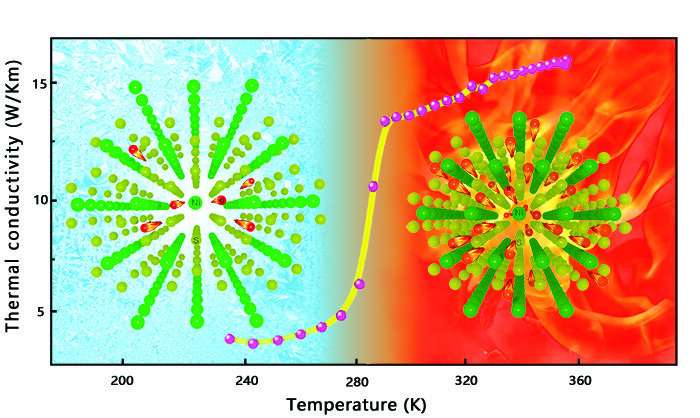The abrupt change in thermal conductivity and its mechanism for the hexagonal sulfide Ni1-xFexS. Credit: ZHANG Xuekai
About 90% of the world's energy use involves generation or manipulation of heat, while controlling thermal transport is yet a challenge in many fields, varying from the micro- and nano-scale electronic devices to aeronautics. Materials exhibiting abrupt transition between low and high thermal conductance states are strongly desired for rapidly developing thermal regulation applications.
In a new report published on Acta Materialia, a joint team led by Prof. Tong Peng and Prof. Zhang Yongsheng from the Institute of Solid State Physics (ISSP) of the Hefei Institutes of Physical Science (HFIPS) reported their new findings about a sharp change of thermal conductivity up to 200% within a temperature interval of 40 Kelvin in sulfides Ni1-xFexS.
"The observed change of thermal conductivity exceeds those reported in other thermal regulation materials," said Prof. Tong, "Moreover, the operation temperature can be well adjusted by tuning the iron concentration, making such a thermal conductivity regulation scheme adaptable to different application needs."
"We did theoretical calculations," said Prof. Zhang, a theoretical physicist, "and found that the large jump of thermal conductivity roots from the dramatic modification of the electronic structure at the first-order phase transition."
The material is brittle in nature, so the group did something more. They added silver to improve the machinability and thermal cycling stability, which is beneficial to the practical applications.
The large jump of thermal conductivity along with reversibility suggests that the current materials are a new promising material for thermal management applications. Besides, the hexagonal sulfides are easy to synthesize and the raw materials are environmentally friendly.
Lots of application can be introduced to this material. For instance, it can be used to construct thermal diodes. Similar to electronic diodes, thermal diodes only allow heat flow to travel in a specific direction, while blocking in the opposite direction. Since its thermal conductivity can be adjusted autonomously, this material can also be applied to maintain at the optimal temperature against the environment temperature variation.
More information: X.K. Zhang et al. High-contrast, reversible change of thermal conductivity in hexagonal nickel-iron sulfides, Acta Materialia (2021). DOI: 10.1016/j.actamat.2021.116709
Provided by Chinese Academy of Sciences
























